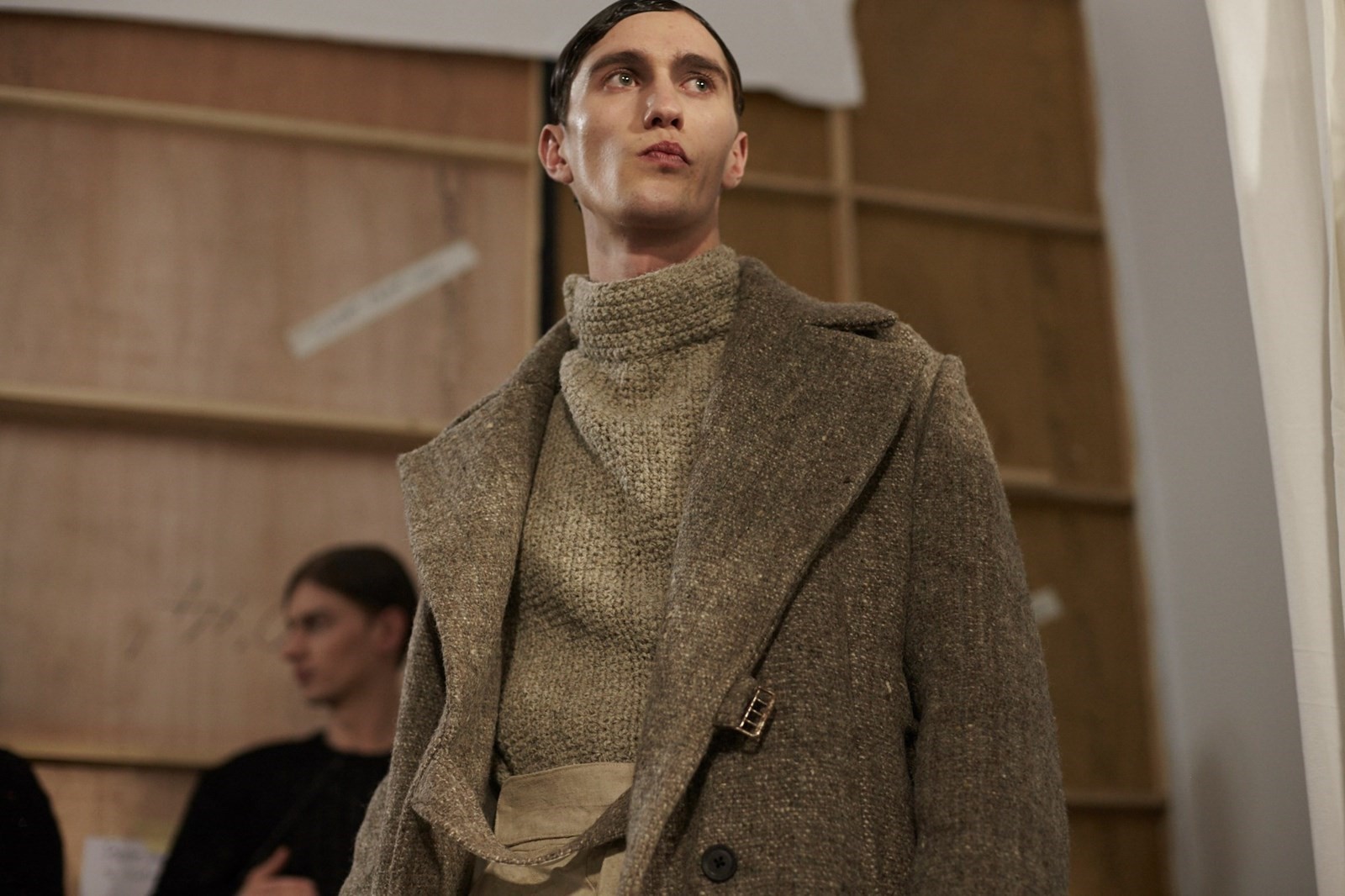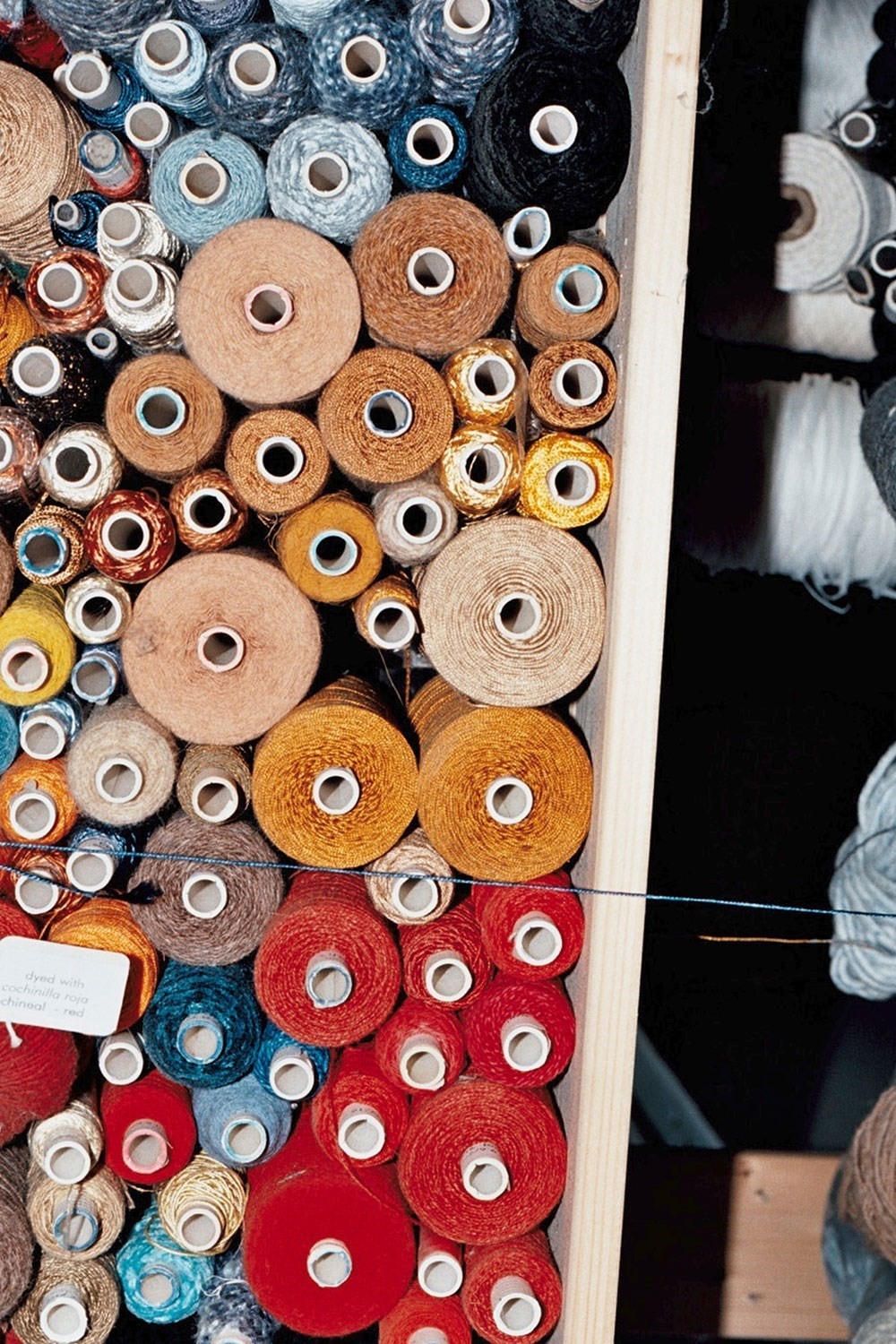For a long time, Britain’s various counties were punctuated by textile mills, each one specialising in fabrics and materials specific to the local region. Then globalisation happened and now they’re far and few between, with the remaining mills a somewhat rustic memento of pastoral British craft. A handful of young fashion designers, however, are returning to localised fabric production in a bid for sustainability, rather than nationalism. John Alexander Skelton, Faustine Steinmetz and Phoebe English are unified by their interests in sustainable textile development, essentially working as textile mills themselves. Each of these London-based designers, who all happen to be alumni of Central Saint Martins’ esteemed MA programme, share a vested interest in the making, sourcing, and upcycling textiles. Together, they’re igniting a discussion about what can be done by young designers to reduce carbon footprints, find alternatives to chemical treatments and avoid excessive waste. What’s more, it signifies a generational return to the skill of the hand – the Manus to the Machina, if you will. Even untrained eyes will recognise a distinctly human presence in the aesthetics and surface of their designs, a result of the laboured processes that they oversee every step of the way. We spoke to each of them to find out more about what it takes to be a young designer at the forefront of a textile-led revolution.

John Alexander Skelton
As part of this year’s fresh crop of MA graduates, and the L’Oréal prize winner at that, John Alexander Skelton is preparing to launch his own menswear label with his brothers, Ryan and Danny. An evolution of his final collection, which established an ethical and organic process that started at the crops and ended up on the catwalk. “I wanted to make as many fabrics as possible on this isle,” explains Skelton. “In the past, families would have grown crops like flax, harvested it and taken the fibres and spun it to create the linen and hemp to make clothes. Now, people want something new all the time and it’s unhealthy. Why not have one shirt that’s well made instead of ten that are shit?” In this sense, Skelton seeks progression in regression, harking back to periods of humbler living. It all began when Skelton stumbled upon Mass-Observation, Tom Harisson’s radical anthropological study of working class communities in Northern England in the mid-1930s, carried out by young surrealists and photographically catalogued by Humphrey Spender. “The materiality comes from the working class – I wanted it to be raw, humble, and craft-based, and I liked the idea of something looking really dirty but it actually being clean. One of the things I hate about fashion is its obsession with everything looking very clean; a lot of my references were images of the working class covered in dirt.”
“Why not have one shirt that’s well made instead of ten that are shit?” – John Skelton
The complex stages of production informed Skelton’s farmyard aesthetic of dishevelled tailoring, sweeping outerwear, generous tailoring and cosy knitwear. Some fabrics were stained with wine and buried in the ground for a worn-in look, whilst several patchworks were compiled of repurposed cottons and linens, including his grandmother’s bedsheets. When Skelton learnt that only 3% of wool woven in Britain is from British fleece, he took it upon himself to find a supplier of British fleece, which is often coarser and hence less in-demand, and have it woven to his specifications and treated naturally. All of the cotton for his shirting is fair-trade Khadi, the hand-spun and handwoven Indian textile that Gandhi pioneered as an act of anti-Imperialist protest. Looking forward, the York-born designer is eager to develop crop-to-catwalk processes and inspire other designers to take similar approaches, “I want to spearhead it as an alternative. If I propose my collection as sustainable, it comes hand in hand with wanting other people to change the way they produce things. I won’t have enough impact on my own.”

Faustine Steinmetz
With two large looms and almost a dozen smaller ones, Faustine Steinmetz’s north London HQ is less of a fashion designer’s studio as we know it and more of a miniature textile mill. This is where the Paris-born designer creates her mainstay of artful denim, as well as the rugging fabrics, mohair and ribbed cotton that permeated her latest presentation at London Fashion Week. “After I finished my MA, I was a bit scared of fashion and I worked as graphic designer for a couple of years,” says Steinmetz, who admits to being a digital printer at college. “One day I went to The Handweavers Studio and found this small, cheap loom and thought it would be fun to start a new project and re-built my portfolio, so I bought it and learnt how to weave by watching YouTube videos.” From there, a collection of trompe l’œil felted denim was born, cleverly created from upcycled jeans were pulped and re-made into yarn, and her business was established with her and her partner, Michael Hawkins at the helm.
“My best ideas mostly come from mistakes” – Faustine Steinmetz
For Faustine, sustainability is a question of making the right choices along the way. She sources wool for her mohair from British farms with their own sheep, works with cotton suppliers that recycle the large amount of water used to make it, avoids any kind of animal products, and on an everyday level, she tries to keep her business as paper and pen-free as possible. Steinmetz develops her fabrications by experimenting at the loom and playing with different yarns, rather than the mathematical method employed by many trained weavers. “My best ideas mostly come from mistakes,” says Steinmetz. “I will do something like spill my coffee all over a weave and realise that it looks better in brown! Or for this season, the carpeted bags came from seeing a scrap of fabric on a bag I have in the middle of a heap of mess.” With demand for her product growing, Steinmetz says that she and Hawkins often spend weeks on end without a break, due to the challenges of being both a designer and producer. For S/S17, they’ve developed a relationship with artisanal weavers in Burkina Faso, courtesy of a United Nations programme promoting Fairtrade craftsmanship. Rest assured, the looms in her studio will still be running at full speed. “I don’t understand what so many people are doing for six months,” she says with a giggle. “They just have to order their fabric and then it comes and they have to sew it. When I go to some of my friends’ studios, they’re always so busy and I don’t understand how!”

Phoebe English
When Phoebe English graduated in 2011, the London fashion industry was enjoying a passionate love affair with digital printing. Designers such as Mary Katrantzou, Peter Pilotto and Jonathan Saunders were its emboldened proprietors, unknowingly inspiring a generation of designers below them to take a distinctly different approach. “There was this urgent need for laboured surfaces,” says English, who graduated in the same class as Faustine Steinmetz. “I couldn’t look at another digital print and I didn’t know how to do one – it just wasn’t how I was trained or taught how to make things.” Her first two collections out of college were experimental textiles, combining unlikely materials such as fringed rubber and strands of hair. Today, her designs are less extreme, incorporating elements of textile development into a wider selection. “When you start selling to shops, you realise the manufacturing time you have before you have to deliver the collections is terrifyingly short,” she explains. “We never went down the NewGen path or had BFC sponsorship, so our stockists from the beginning were extremely important to us because that was the only way we were receiving any income. Because of that we’ve always been really dedicated to facilitating the best delivery dates, which is difficult when you’re hand-making everything.”
“Every season we do something different, but it always starts with the textiles” – Phoebe English
English’s textiles are all made in either her south-east London studio or by London-based workshops that are “never more than a tube journey away.” She has a need to know the people that are helping make her textiles and the conditions in which they do so, and considers outsourcing production to different country illogical, unsustainable and a thread to the quality of the end product. Her trepidation is not unfounded when one reflects upon the intricate and complex techniques that she favours. “I spent a lot of time in second-hand and antique bookshops in the craft section, looking up techniques that are a bit old-fashioned and maybe aren’t used anymore,” she says. Some of these include WWI-era macramé, 16th-century lace making, peacock-stitched crochet, dyed parcel string carpeting and weaves of shredded silk and shrimp fishing nets. “Every season we do something different, but it always starts with the textiles.”
